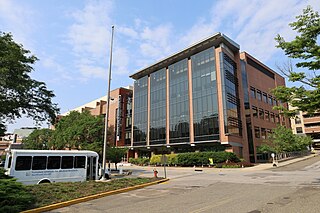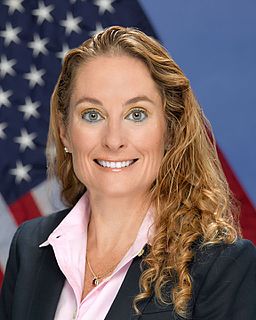
Tumor necrosis factor is an adipokine and a cytokine. TNF is a member of the TNF superfamily, which consists of various transmembrane proteins with a homologous TNF domain.
Glycated hemoglobin is a form of hemoglobin (Hb) that is chemically linked to a sugar. Most monosaccharides, including glucose, galactose and fructose, spontaneously bond with hemoglobin, when present in the bloodstream of humans. However, glucose is less likely to do so than galactose and fructose, which may explain why glucose is used as the primary metabolic fuel in humans.
DOV Pharmaceutical was a biotechnology company that focused on therapies primarily for central nervous system conditions. It was founded in 1995 by former employees of American Cyanamid, and in 1998 it in-licensed drugs discovered at American Cyanamid for further development. It held an IPO on NASDQ in 2002, and its shares plunged days later after negative details about a past relationship between Élan and DOV emerged.

Alagebrium was a drug candidate developed by Alteon, Inc. It was the first drug candidate to be clinically tested for the purpose of breaking the crosslinks caused by advanced glycation endproducts (AGEs), thereby reversing one of the main mechanisms of aging. Through this effect Alagebrium is designed to reverse the stiffening of blood vessel walls that contributes to hypertension and cardiovascular disease, as well as many other forms of degradation associated with protein crosslinking. Alagebrium has proven effective in reducing systolic blood pressure and providing therapeutic benefit for patients with diastolic heart failure.
Fructosamines are compounds that result from glycation reactions between a sugar and a primary amine, followed by isomerization via the Amadori rearrangement. Biologically, fructosamines are recognized by fructosamine-3-kinase, which may trigger the degradation of advanced glycation end-products. Fructosamine can also refer to the specific compound 1-amino-1-deoxy-D-fructose (isoglucosamine), first synthesized by Nobel laureate Hermann Emil Fischer in 1886.
A TNF inhibitor is a pharmaceutical drug that suppresses the physiologic response to tumor necrosis factor (TNF), which is part of the inflammatory response. TNF is involved in autoimmune and immune-mediated disorders such as rheumatoid arthritis, ankylosing spondylitis, inflammatory bowel disease, psoriasis, hidradenitis suppurativa and refractory asthma, so TNF inhibitors may be used in their treatment. The important side effects of TNF inhibitors include lymphomas, infections, congestive heart failure, demyelinating disease, a lupus-like syndrome, induction of auto-antibodies, injection site reactions, and systemic side effects.

TNF receptor associated periodic syndrome (TRAPS) is a periodic fever syndrome associated with mutations in a receptor for the molecule tumor necrosis factor (TNF) that is inheritable in an autosomal dominant manner. Individuals with TRAPS have episodic symptoms such as recurrent high fevers, rash, abdominal pain, joint/muscle aches and puffy eyes.

Jan T. Vilček is a biomedical scientist, educator, inventor and philanthropist. He is a professor in the department of microbiology at the New York University School of Medicine, and chairman and CEO of The Vilcek Foundation. Vilček, a native of Bratislava, Slovakia, received his M.D. degree from Comenius University Medical School, Bratislava in 1957; and his Ph.D. in Virology from the Institute of Virology, Czechoslovak Academy of Sciences, Bratislava, Czechoslovakia in 1962. In 1964, Vilček, with his wife Marica, defected from Communist Czechoslovakia during a three-day visit to Vienna. In 1965, the Vilčeks immigrated to the United States, and have since lived in New York City. Vilček devoted his scientific career to studies of soluble mediators that regulate the immune system (cytokines), including interferon and tumor necrosis factor (TNF).

North Shore University Hospital is a part of Northwell Health, New York State's largest healthcare provider and private employer. It is a primary teaching hospital for the Donald & Barbara Zucker School of Medicine at Hofstra/Northwell, offering residency programs, postgraduate training programs and clinical fellowships. It is located in Manhasset, New York.

Bruce Alan Beutler is an American immunologist and geneticist. Together with Jules A. Hoffmann, he received one-half of the 2011 Nobel Prize in Physiology or Medicine, for "their discoveries concerning the activation of innate immunity".
Molecular Medicine is a peer-reviewed open access medical journal published by The Feinstein Institute for Medical Research. It was established in 1994 by the Picower Institute for Medical Research, which had been established in 1991 by Anthony Cerami with funding from Jeffry Picower which eventually was absorbed into Feinstein.

The Feinstein Institutes for Medical Research in Manhasset, Nassau County, New York, United States, on Long Island, constitute the research arm of Northwell Health. Feinstein is home to 50 research labs, 2,500 clinical research studies, and 5,000 professional and support staff. Feinstein scientists conduct research in molecular medicine, genetics, cancer, brain research, mental health, autoimmunity and bioelectronic medicine, among others. Feinstein is the laboratory and faculty home of the Elmezzi Graduate School of Molecular Medicine. Students without an MD degree may earn a PhD in molecular medicine via the Donald and Barbara Zucker School of Medicine at Hofstra/Northwell, as part of the medical school's MD/PhD or PhD programs.
The Dr. Paul Janssen Award for Biomedical Research is given annually by Johnson & Johnson to honor the work of an active scientist in academia, industry or a scientific institute in the field of biomedical research. It was established in 2004 and perpetuates the memory of Paul Janssen, the founder of Janssen Pharmaceutica, a Johnson & Johnson subsidiary.
Kenneth S. Warren was an American scientist, physician, educator and public health advocate. He was an expert on tropical disease, in particular schistosomiasis.
"Sickle Cell Anemia, a Molecular Disease" is a 1949 scientific paper by Linus Pauling, Harvey A. Itano, Seymour J. Singer and Ibert C. Wells that established sickle-cell anemia as a genetic disease in which affected individuals have a different form of the metalloprotein hemoglobin in their blood. The paper, published in the November 25, 1949 issue of Science, reports a difference in electrophoretic mobility between hemoglobin from healthy individuals and those with sickle-cell anemia, with those with sickle cell trait having a mixture of the two types. The paper suggests that the difference in electrophoretic mobility is probably due to a different number of ionizable amino acid residues in the protein portion of hemoglobin, and that this change in molecular structure is responsible for the sickling process. It also reports the genetic basis for the disease, consistent with the simultaneous genealogical study by James V. Neel: those with sickle-cell anemia are homozygous for the disease gene, while heterozygous individuals exhibit the usually asymptomatic condition of sickle cell trait.

Semapimod (INN), formerly known as CNI-1493, is an investigational new drug which has anti-inflammatory, anti-cytokine, immunomodulatory, antiviral and antimalarial properties.
Pimagedine, also known as aminoguanidine, is an investigational drug for the treatment of diabetic nephropathy that is no longer under development as a drug. Pimagedine functions as an inhibitor of diamine oxidase and nitric oxide synthase. It acts to reduce levels of advanced glycation end products (AGEs) through interacting with 3-deoxyglucosone, glyoxal, methylglyoxal, and related dicarbonyls. These reactive species are converted to less reactive heterocycles by this condensation reaction.
Jeffry M. Picower was an American investor involved in the Madoff investment scandal. He was the largest beneficiary of Madoff's Ponzi scheme, and his widow agreed to have his estate settle the claims against it by Madoff trustee Irving Picard for $7.2 billion, the largest single forfeiture in American judicial history.

Dena Minning Grayson is an American medical doctor, researcher and politician. In 2016, she ran unsuccessfully for the Democratic nomination for the United States House of Representatives for Florida's 9th congressional district.
Neurobiological Technologies, Inc. ("NTI") was a biotechnology company that was founded in 1987 by Enoch Callaway and John B. Stuppin to in-license and develop drugs primarily to treat neurological conditions; the company was dissolved in 2009 after the failure of its drug candidate ancrod in a Phase III trial for ischemic stroke.









